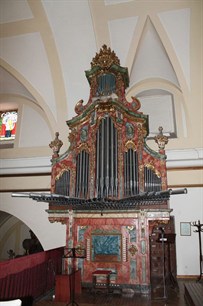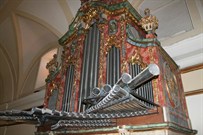The “Churrigueresco” organ in the church of San Salvador (Leganés, Madrid)
 The Church of San Salvador (the Holy Saviour) of LeganésLocated a few kilometers from Madrid and now part of the metropolitan area of the capital, Leganés was founded in the thirteenth century, during the reign of Alfonso X el Sabio. Don Juan de Austria, the illegitimate son of Charles V, stayed there for a short period (1550-1554) while still a child. In 1627 it became a Villa de señorío and Diego Messia Felipe de Guzmán was appointed the first Marquis of Leganés by Philip IV. Currently, the city has a branch of the University Carlos III of Madrid. had a seventeenth century organ, the case of which was rebuilt by José Benito de Churriguera, the famous author of altarpieces. In 1735 the organ was finished, with twelve registers to the right and eleven registers to the left. In 1790 the instrumental part was changed, leaving Churriguera’s case. The whole operation was entrusted to the organ builder José de VerdalongaJosé de Verdalonga was the most famous organ builder of the late nineteenth century. He enjoyed the title of organ builder of the Monastery of San Lorenzo de El Escorial for having restored the instrument which is still there., who has only left this expression of his work in Madrid.
The Church of San Salvador (the Holy Saviour) of LeganésLocated a few kilometers from Madrid and now part of the metropolitan area of the capital, Leganés was founded in the thirteenth century, during the reign of Alfonso X el Sabio. Don Juan de Austria, the illegitimate son of Charles V, stayed there for a short period (1550-1554) while still a child. In 1627 it became a Villa de señorío and Diego Messia Felipe de Guzmán was appointed the first Marquis of Leganés by Philip IV. Currently, the city has a branch of the University Carlos III of Madrid. had a seventeenth century organ, the case of which was rebuilt by José Benito de Churriguera, the famous author of altarpieces. In 1735 the organ was finished, with twelve registers to the right and eleven registers to the left. In 1790 the instrumental part was changed, leaving Churriguera’s case. The whole operation was entrusted to the organ builder José de VerdalongaJosé de Verdalonga was the most famous organ builder of the late nineteenth century. He enjoyed the title of organ builder of the Monastery of San Lorenzo de El Escorial for having restored the instrument which is still there., who has only left this expression of his work in Madrid.
The case consists, like that of any Spanish Baroque organ, of three bodies. At the bottom is the consoleThe organist’s place, where the keyboard is with the tiradoresThe tiradores are knobs that control the different registers, positioned to the side of the keyboard. on the sides and the original keyboard, made with inlays of bone and ebony. The central body, with the frieze of trumpets, in turn, contains the secretoThe box that contains the mechanisms for the distribution of the wind to the pipes and tuberías and has five windows with rounded castillos de tubosThe term refers to the way to place the pipes in the windows of the cabinet, always in a geometric way and in symmetry. They are reminiscent of the towers of castles.. In this body, the ornaments are striking for their originality which end in a wavy cornice. At the top, there is a medallion of tubos canónigosTubes that do not produce sound and which are placed on the façade of an organ as an ornament and to maintain symmetry. ending in a curved pedimment, adorned with the head of a golden cherub. The entire cabinet is in red and green marble, inlaid with gold.
 At the end of the twentieth century, the instrument found itself in a very poor state of preservation. With the restoration a way was sought to maintain the structure as projected by Verdalonga, but it was still necessary to replace a large part of the pipes and restore the organ case.
At the end of the twentieth century, the instrument found itself in a very poor state of preservation. With the restoration a way was sought to maintain the structure as projected by Verdalonga, but it was still necessary to replace a large part of the pipes and restore the organ case.
Technical data:
- Keyboard with 28 notes, C-c ‘”
- Short eighth
- 9 peanas de Contras
- Mechanical transmission in range and secreto de corredera
